Ask a question from expert
Aster Gabremadhan SE6P05 Aster Gabremadhan SE6P05 Aster Gabremadhan SE6P05 Aster Gabremadhan SE6P05 Aster Gabremadhan SE6P05 Aster Gabremadhan SE6P05 Aster Gabremadhan SE6P05 Aster Gabremadhan
60 Pages16384 Words437 Views
Added on 2020-02-05
About This Document
RESEARCH: A study on different ways of how parents and practitioners can effectively support multilingual children ABSTRACT Green, 1998 suggested that speaking more than one language on a constant basis helps an individual in actively training his/her brain. It also focused on developing a well-defined understanding regarding the subject and educational aspects of the study.
Aster Gabremadhan SE6P05 Aster Gabremadhan SE6P05 Aster Gabremadhan SE6P05 Aster Gabremadhan SE6P05 Aster Gabremadhan SE6P05 Aster Gabremadhan SE6P05 Aster Gabremadhan SE6P05 Aster Gabremadhan
Added on 2020-02-05
BookmarkShareRelated Documents
Aster Gabremadhan SE6P05
Aster we have done on the abstract, introduction and literature
review. Therefore, I will give you feedback on methodology and
findings chapters.
RESEARCH:
A study on different ways of how parents and
practitioners can effectively support
multilingual children
ABSTRACT
Green, 1998 suggested that speaking more than one language on a constant basis helps an
individual in actively training his/her brain. It helps in developing well defined conversation
skills for a person. The overall focus of my study will be to analyse and understand the concept
and consequences of multilingualism within children. It also focused on developing a well-
defined understanding regarding the subject and educational aspects of the study. The analysis of
different aspects of the theories will be evaluated to understand what factors affect bilingualism
within a child. The study will also focus on understanding the impact of the stated factor on the
growth and development aspects of child. The study revealed that there are different notions in
the society related to the subject of bilingualism. The process of the carrying out investigation is
comprised of series of steps. This acts as an aid in accomplishment of the research aim in an
1
Aster we have done on the abstract, introduction and literature
review. Therefore, I will give you feedback on methodology and
findings chapters.
RESEARCH:
A study on different ways of how parents and
practitioners can effectively support
multilingual children
ABSTRACT
Green, 1998 suggested that speaking more than one language on a constant basis helps an
individual in actively training his/her brain. It helps in developing well defined conversation
skills for a person. The overall focus of my study will be to analyse and understand the concept
and consequences of multilingualism within children. It also focused on developing a well-
defined understanding regarding the subject and educational aspects of the study. The analysis of
different aspects of the theories will be evaluated to understand what factors affect bilingualism
within a child. The study will also focus on understanding the impact of the stated factor on the
growth and development aspects of child. The study revealed that there are different notions in
the society related to the subject of bilingualism. The process of the carrying out investigation is
comprised of series of steps. This acts as an aid in accomplishment of the research aim in an
1
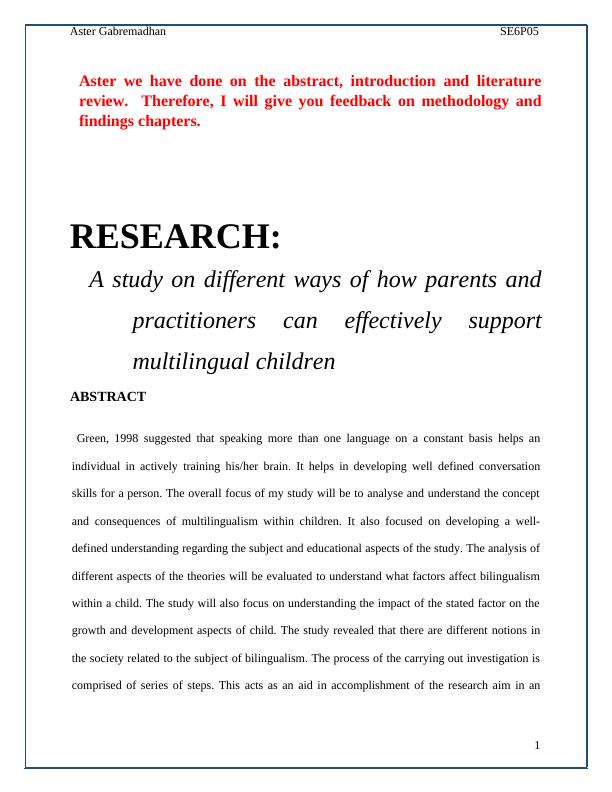
Aster Gabremadhan SE6P05
effective manner. The initial step is related with determination of the problem under
investigation. By the means of carrying out investigation the issue under research can be resolved
with greater effectiveness. Following this another stage is related with writing down the proposal
of the research. This is comprised of determination of the aims and objectives of the research.
The key findings of the study revealed that parent involvement and a constructive mutual
collaboration with practitioners is crucial to support children bilingualism. It was also analysed
that there are positive academic outcomes stemming from parent involvement ranging from
benefits in early childhood to adolescence.
2
effective manner. The initial step is related with determination of the problem under
investigation. By the means of carrying out investigation the issue under research can be resolved
with greater effectiveness. Following this another stage is related with writing down the proposal
of the research. This is comprised of determination of the aims and objectives of the research.
The key findings of the study revealed that parent involvement and a constructive mutual
collaboration with practitioners is crucial to support children bilingualism. It was also analysed
that there are positive academic outcomes stemming from parent involvement ranging from
benefits in early childhood to adolescence.
2
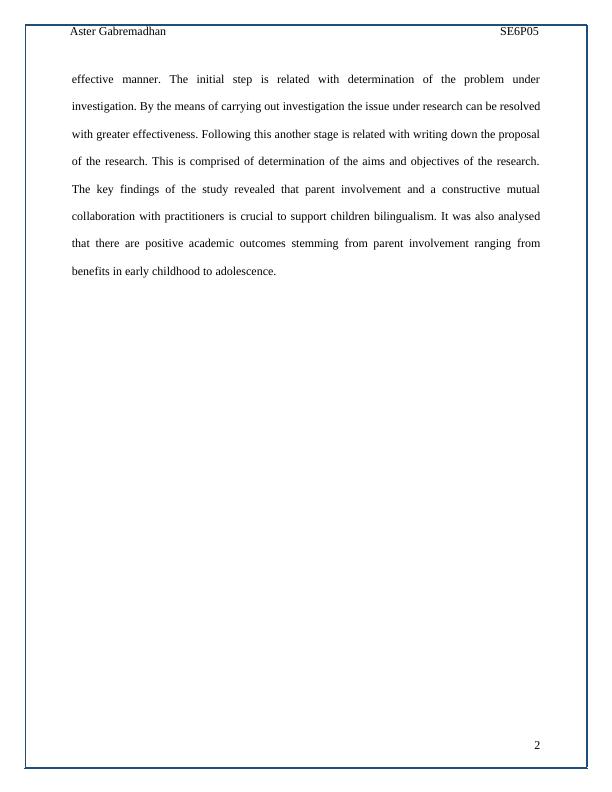
Aster Gabremadhan SE6P05
TABLE OF CONTENTS
INTRODUCTION...........................................................................................................................4
LITERATURE REVIEW................................................................................................................7
RESEARCH METHODOLOGY..................................................................................................17
Research Paradigm...................................................................................................................18
Research approach....................................................................................................................20
Research type............................................................................................................................21
Research design........................................................................................................................22
Data collection..........................................................................................................................23
Sampling...................................................................................................................................24
Procedure..................................................................................................................................25
Data analysis.............................................................................................................................26
Ethical consideration................................................................................................................26
Research limitation...................................................................................................................27
RESULTS AND FINDINGS........................................................................................................30
Introduction..............................................................................................................................30
Thematic analysis.....................................................................................................................30
Interview results for practitioners.............................................................................................42
CONCLUION AND RECOMMENDATIONS............................................................................46
Introduction..............................................................................................................................46
Conclusion................................................................................................................................46
Recommendations....................................................................................................................47
REFERENCES..............................................................................................................................49
APPENDIX...................................................................................................................................52
3
TABLE OF CONTENTS
INTRODUCTION...........................................................................................................................4
LITERATURE REVIEW................................................................................................................7
RESEARCH METHODOLOGY..................................................................................................17
Research Paradigm...................................................................................................................18
Research approach....................................................................................................................20
Research type............................................................................................................................21
Research design........................................................................................................................22
Data collection..........................................................................................................................23
Sampling...................................................................................................................................24
Procedure..................................................................................................................................25
Data analysis.............................................................................................................................26
Ethical consideration................................................................................................................26
Research limitation...................................................................................................................27
RESULTS AND FINDINGS........................................................................................................30
Introduction..............................................................................................................................30
Thematic analysis.....................................................................................................................30
Interview results for practitioners.............................................................................................42
CONCLUION AND RECOMMENDATIONS............................................................................46
Introduction..............................................................................................................................46
Conclusion................................................................................................................................46
Recommendations....................................................................................................................47
REFERENCES..............................................................................................................................49
APPENDIX...................................................................................................................................52
3
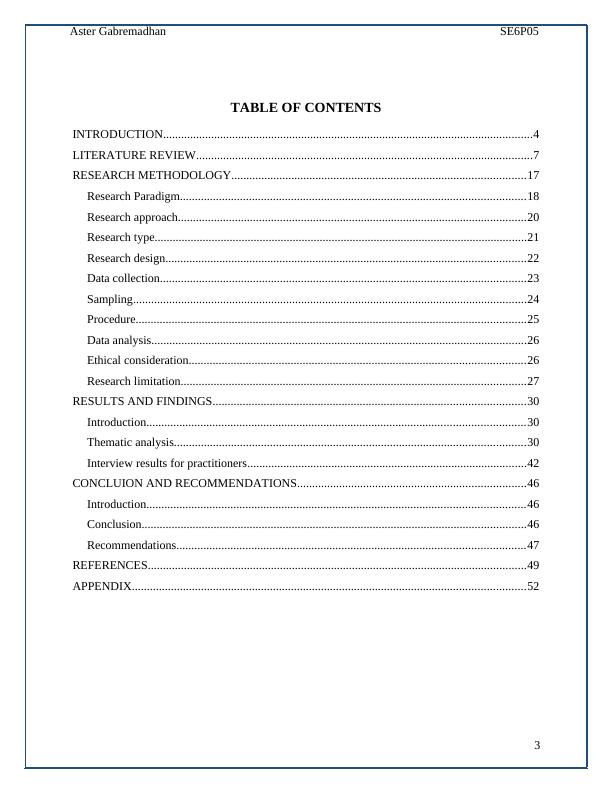
Aster Gabremadhan SE6P05
INTRODUCTION
My first encounter to the concept of bilingualism happened while working in a private nursery
which was filled with children having multiple language fluency. I faced the similar situation
regularly however it never struck to me that this could help me in enhancing my own
communication skills. I am a bilingual individual and my four-year daughter in a monolingual
child but this is because we never trained her in using more than one language because of an
unconscious assumption that it will ultimately confuse her young brain. However, analysing the
present situation I remembered the theorist of child development who gave different theories on
language acquisition approach of a child and their aspects. Thus, I have developed a keen interest
in getting acquainted with the concept of bilingualism and learning about the theories and social
aspects of the same.
Green, 1998 suggested that speaking more than one language on a constant basis helps an
individual in actively training his/her brain. It helps in developing well defined conversation
skills for a person. I analysed the application of theory on my own daughter to evaluate that does
bilingual practice develop her brain's response. While learning about the concept I initiated the
approach by speaking with my daughter in my mother tongue. To my surprise, she was able to
understand the language effectively however could not respond in the same language. This
influenced me to learn more about the subject and core concepts and facts related with the topic.
I realised that across time, many researchers, practitioners and parents have asked and raised
concerns regarding bilingualism and multilingualism such as the effect of concept on
communication, mental and cognitive development (Albon, 2005). I chose the stated topic
because the particular experience. Moreover, I also realised and that deep inside me I had keen
interest and love for different languages. I know the basic sentence formation from 6 different
4
INTRODUCTION
My first encounter to the concept of bilingualism happened while working in a private nursery
which was filled with children having multiple language fluency. I faced the similar situation
regularly however it never struck to me that this could help me in enhancing my own
communication skills. I am a bilingual individual and my four-year daughter in a monolingual
child but this is because we never trained her in using more than one language because of an
unconscious assumption that it will ultimately confuse her young brain. However, analysing the
present situation I remembered the theorist of child development who gave different theories on
language acquisition approach of a child and their aspects. Thus, I have developed a keen interest
in getting acquainted with the concept of bilingualism and learning about the theories and social
aspects of the same.
Green, 1998 suggested that speaking more than one language on a constant basis helps an
individual in actively training his/her brain. It helps in developing well defined conversation
skills for a person. I analysed the application of theory on my own daughter to evaluate that does
bilingual practice develop her brain's response. While learning about the concept I initiated the
approach by speaking with my daughter in my mother tongue. To my surprise, she was able to
understand the language effectively however could not respond in the same language. This
influenced me to learn more about the subject and core concepts and facts related with the topic.
I realised that across time, many researchers, practitioners and parents have asked and raised
concerns regarding bilingualism and multilingualism such as the effect of concept on
communication, mental and cognitive development (Albon, 2005). I chose the stated topic
because the particular experience. Moreover, I also realised and that deep inside me I had keen
interest and love for different languages. I know the basic sentence formation from 6 different
4

Aster Gabremadhan SE6P05
languages which has helped in managing my interest in the area. I never thought that bilingual
language will help me as a parent and will lead to become a practitioner as well. Hence, the
following topic has been chosen as it will help me in strengthening my knowledge on the subject.
It will also help me to become an expert which in turn will enhance my capabilities of advising
parents and other practitioners about the related subject. Alderson, (1995) states that a strong
desire and motivation is important to guide and make right choices of research in order to change
at work, for further development through acquiring higher knowledge. I am convinced that I will
be able to contribute useful findings by conducting the research which will help in assisting
parents and children for the specific manner. Parents are effectively contributing in the related
subject by providing effective guidance to their children however it has been analysed that there
is wide literature gap for the subject. There are ample of questions which remains unanswered by
the practitioners as well.
The overall focus of my study will be to analyse and understand the concept and consequences
of multilingualism within children. It also focused on developing a well-defined understanding
regarding the subject and educational aspects of the study. The analysis of different aspects of the
theories will be evaluated to understand what factors affect bilingualism within a child. The
study will also focus on understanding the impact of the stated factor on the growth and
development aspects of child. According to Diamond (2010) it has been analysed that internal
and external bilingualism are both the crucial aspect of determining the understanding and
learning aspects of children. As per the study the development measures of child's development
are significant in creating an indefinite impact on learning issues within the economy. Moreover,
the evaluation regarding the tools and techniques for learning abilities to develop the skills of the
children is also evaluated to be a significant aspect. Hence, the study will develop an effective
5
languages which has helped in managing my interest in the area. I never thought that bilingual
language will help me as a parent and will lead to become a practitioner as well. Hence, the
following topic has been chosen as it will help me in strengthening my knowledge on the subject.
It will also help me to become an expert which in turn will enhance my capabilities of advising
parents and other practitioners about the related subject. Alderson, (1995) states that a strong
desire and motivation is important to guide and make right choices of research in order to change
at work, for further development through acquiring higher knowledge. I am convinced that I will
be able to contribute useful findings by conducting the research which will help in assisting
parents and children for the specific manner. Parents are effectively contributing in the related
subject by providing effective guidance to their children however it has been analysed that there
is wide literature gap for the subject. There are ample of questions which remains unanswered by
the practitioners as well.
The overall focus of my study will be to analyse and understand the concept and consequences
of multilingualism within children. It also focused on developing a well-defined understanding
regarding the subject and educational aspects of the study. The analysis of different aspects of the
theories will be evaluated to understand what factors affect bilingualism within a child. The
study will also focus on understanding the impact of the stated factor on the growth and
development aspects of child. According to Diamond (2010) it has been analysed that internal
and external bilingualism are both the crucial aspect of determining the understanding and
learning aspects of children. As per the study the development measures of child's development
are significant in creating an indefinite impact on learning issues within the economy. Moreover,
the evaluation regarding the tools and techniques for learning abilities to develop the skills of the
children is also evaluated to be a significant aspect. Hence, the study will develop an effective
5

Aster Gabremadhan SE6P05
clear understanding regarding the learning and growth aspects of the stated study to analyse the
social and cultural aspect of language on learning and development capability of the children.
The study revealed that there are different notions in the society related to the subject of
bilingualism. Aubrey (2000) sated that parents of bilingual childminders are often concerned
about the issues related their mind and brain functions. The myths related to crucial a critical
period which may confuse a child's brain regarding multiple language, it has also been analysed
some parents have claimed that speaking multiple language is smarter than monolingual child.
Blenkin and Kelly, (1997) analysed that a confusion within parents of monolingual children
regarding the learning difficulties of bilinguals. Analysed all the above issues motivated me to
choose the research aim which will help in effectively answering the above related issues of the
parents and practitioner of the field. I will focus on attaining the research aim by referring to
different theories, scientific findings, social aspects and will also develop personal experience in
attaining effective and well defined results regarding the subjected issue. Finally, by answering
those questions, I will be able to provide right recommendations and back it up with the right
evidence. The question I will ask and will look to answer will be “How to support parents and
practitioners effectively with multilingual children”. I will carry on my research by collecting
data parents and practitioners and the content will be composed of the table of content, abstract,
introduction, literature review, methodology, findings, conclusions and my recommendations and
guidelines, bibliography and appendices will also be the part of the stated research analysis. At
the end of my research I will be able to make effective and valid recommendations and point out
areas where parents in some cases and in some cases practitioners need to effectively focus on to
provide and make this language acquisition, a tool to enhance child's learning and to improve
their learning skills.
6
clear understanding regarding the learning and growth aspects of the stated study to analyse the
social and cultural aspect of language on learning and development capability of the children.
The study revealed that there are different notions in the society related to the subject of
bilingualism. Aubrey (2000) sated that parents of bilingual childminders are often concerned
about the issues related their mind and brain functions. The myths related to crucial a critical
period which may confuse a child's brain regarding multiple language, it has also been analysed
some parents have claimed that speaking multiple language is smarter than monolingual child.
Blenkin and Kelly, (1997) analysed that a confusion within parents of monolingual children
regarding the learning difficulties of bilinguals. Analysed all the above issues motivated me to
choose the research aim which will help in effectively answering the above related issues of the
parents and practitioner of the field. I will focus on attaining the research aim by referring to
different theories, scientific findings, social aspects and will also develop personal experience in
attaining effective and well defined results regarding the subjected issue. Finally, by answering
those questions, I will be able to provide right recommendations and back it up with the right
evidence. The question I will ask and will look to answer will be “How to support parents and
practitioners effectively with multilingual children”. I will carry on my research by collecting
data parents and practitioners and the content will be composed of the table of content, abstract,
introduction, literature review, methodology, findings, conclusions and my recommendations and
guidelines, bibliography and appendices will also be the part of the stated research analysis. At
the end of my research I will be able to make effective and valid recommendations and point out
areas where parents in some cases and in some cases practitioners need to effectively focus on to
provide and make this language acquisition, a tool to enhance child's learning and to improve
their learning skills.
6
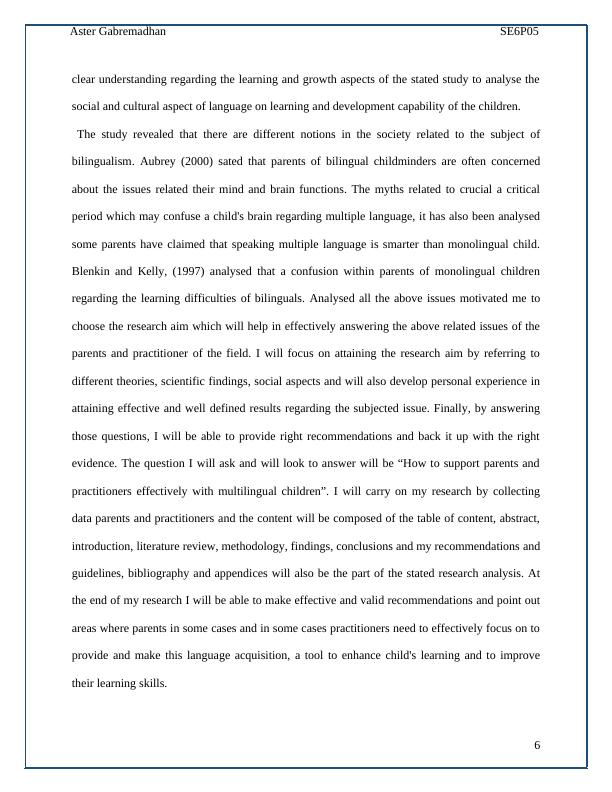
Aster Gabremadhan SE6P05
LITERATURE REVIEW
Language is a tool used to establish an effective and well defined communication measure
between two or more than two individuals. It helps them in sharing ideas, thoughts, and messages
to one another in an effective and well defined manner. Communication focuses on conveying a
particular message while sharing the culture, religion, beliefs, needs and so on (Peer & Reid,
2014). The definition of communication states “An abstract system of symbols and meanings.
This system includes rules that relates symbols and meanings so that we can communicate with
one another”. (Campbell, McNamara and Gilroy, 2004, pp. 430-441). Hence, the overall
representation of communication states that it is an effective and well defined means of
expressing which is understood in an exact manner to another individual which develops a bond
and level of understanding between the people. Cohen, Manion and Morrison (2000) analysed
that language is one of the three key aspects which helps babies to communicate. Language has
been further sub categorised into listening and attention, understanding and speaking. The above
stated elements help the practitioners in equipping an effective language development aspect in
bilingual children.
Both bilingualism and multilingualism are referred to be a complex part of interdisciplinary field.
These are the phenomenon that are devoted to the study of creating, processing as well as
understanding 2 or more distinct set of languages. A bilingual individual is the one who knows to
speak 2 different languages with an ability to proficiently speak each of the languages.
Bilingualism is a particular case of multilingualism where multilingual people are those who can
proficiently speaks more than 2 distinct languages.
The first research on bilingualism was carried out by Ronjat, a French psychologist in the year
1913, which clearly states an evidence that even more than 100 years ago practitioners,
7
LITERATURE REVIEW
Language is a tool used to establish an effective and well defined communication measure
between two or more than two individuals. It helps them in sharing ideas, thoughts, and messages
to one another in an effective and well defined manner. Communication focuses on conveying a
particular message while sharing the culture, religion, beliefs, needs and so on (Peer & Reid,
2014). The definition of communication states “An abstract system of symbols and meanings.
This system includes rules that relates symbols and meanings so that we can communicate with
one another”. (Campbell, McNamara and Gilroy, 2004, pp. 430-441). Hence, the overall
representation of communication states that it is an effective and well defined means of
expressing which is understood in an exact manner to another individual which develops a bond
and level of understanding between the people. Cohen, Manion and Morrison (2000) analysed
that language is one of the three key aspects which helps babies to communicate. Language has
been further sub categorised into listening and attention, understanding and speaking. The above
stated elements help the practitioners in equipping an effective language development aspect in
bilingual children.
Both bilingualism and multilingualism are referred to be a complex part of interdisciplinary field.
These are the phenomenon that are devoted to the study of creating, processing as well as
understanding 2 or more distinct set of languages. A bilingual individual is the one who knows to
speak 2 different languages with an ability to proficiently speak each of the languages.
Bilingualism is a particular case of multilingualism where multilingual people are those who can
proficiently speaks more than 2 distinct languages.
The first research on bilingualism was carried out by Ronjat, a French psychologist in the year
1913, which clearly states an evidence that even more than 100 years ago practitioners,
7
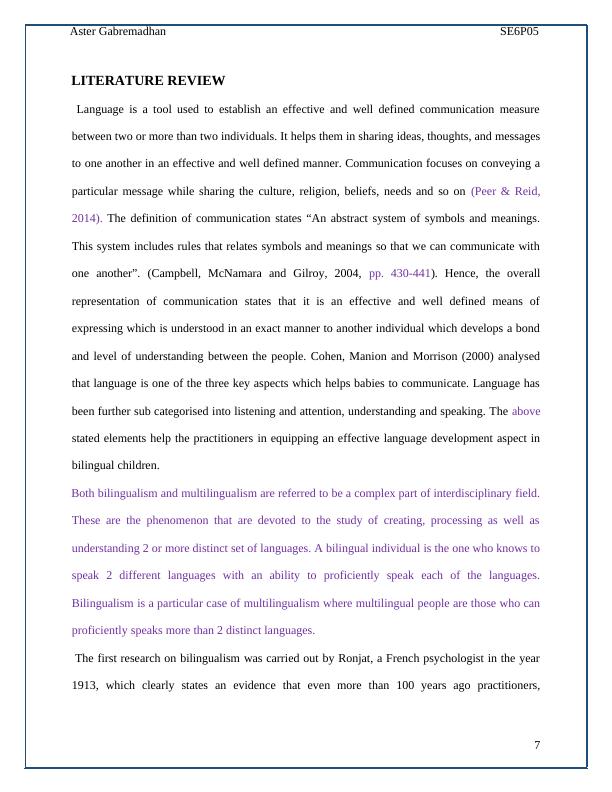
Aster Gabremadhan SE6P05
researchers, sociologists, psychologists and linguistics were fascinated by bilingualism (Aubrey
et al., 2000). Cable, Drury & Robertson (2010) evaluated the basic concept, significance,
benefits, advantages and disadvantages of bilingualism and many other topics. Lewis and
Lindsay (2000) studies indicated that bilingualism did not affect his son's cognitive development
but it improved his linguistic skills. This finding is supported by the
MacNaughton (2001) findings which revealed that “Language is the main tool that promotes
thinking, develops reasoning, and supports cultural activities like reading and writing” thus it can
be argued that bilingualism enhances the cognitive development positively in children (Diamond,
2010). Communication process is developed between thinking and the second language that is
already present in the system which allows the child to learn a new language and this reasoning
is transferred to learn the foreign language (Walliman, 2001). Moreover, Woodhead and
Faulkner, (2000) evaluated that acquiring a second language needs to be studied extensively as it
affects the complete child psychological personality. Hence, it is understood that language is an
essential element in children cognitive development and that the child is undergoing a complex
learning development.
It has been evaluated the second language has been adopted by the individuals for many reasons
which has created a significant and well defined impact on the people and children. Aspects such
as colonialism, trading, immigration it became an advantage and any child or even adult that
speak more than one language is an asset for his family and the society accordingly. Robson
(1993) states that on a worldwide scale half of the population is bilingual therefore many
individuals, communities acquire a second language and thus are fluently bilingual. It is quite
problematic to define monolingualism as there is no proper definition, however if a person has a
low proficiency below the average of the bilingual group that person is defined as monolingual
(Hewson, 2003). Thus, a person can start to learn a language and be familiar but not fluent: in
8
researchers, sociologists, psychologists and linguistics were fascinated by bilingualism (Aubrey
et al., 2000). Cable, Drury & Robertson (2010) evaluated the basic concept, significance,
benefits, advantages and disadvantages of bilingualism and many other topics. Lewis and
Lindsay (2000) studies indicated that bilingualism did not affect his son's cognitive development
but it improved his linguistic skills. This finding is supported by the
MacNaughton (2001) findings which revealed that “Language is the main tool that promotes
thinking, develops reasoning, and supports cultural activities like reading and writing” thus it can
be argued that bilingualism enhances the cognitive development positively in children (Diamond,
2010). Communication process is developed between thinking and the second language that is
already present in the system which allows the child to learn a new language and this reasoning
is transferred to learn the foreign language (Walliman, 2001). Moreover, Woodhead and
Faulkner, (2000) evaluated that acquiring a second language needs to be studied extensively as it
affects the complete child psychological personality. Hence, it is understood that language is an
essential element in children cognitive development and that the child is undergoing a complex
learning development.
It has been evaluated the second language has been adopted by the individuals for many reasons
which has created a significant and well defined impact on the people and children. Aspects such
as colonialism, trading, immigration it became an advantage and any child or even adult that
speak more than one language is an asset for his family and the society accordingly. Robson
(1993) states that on a worldwide scale half of the population is bilingual therefore many
individuals, communities acquire a second language and thus are fluently bilingual. It is quite
problematic to define monolingualism as there is no proper definition, however if a person has a
low proficiency below the average of the bilingual group that person is defined as monolingual
(Hewson, 2003). Thus, a person can start to learn a language and be familiar but not fluent: in
8
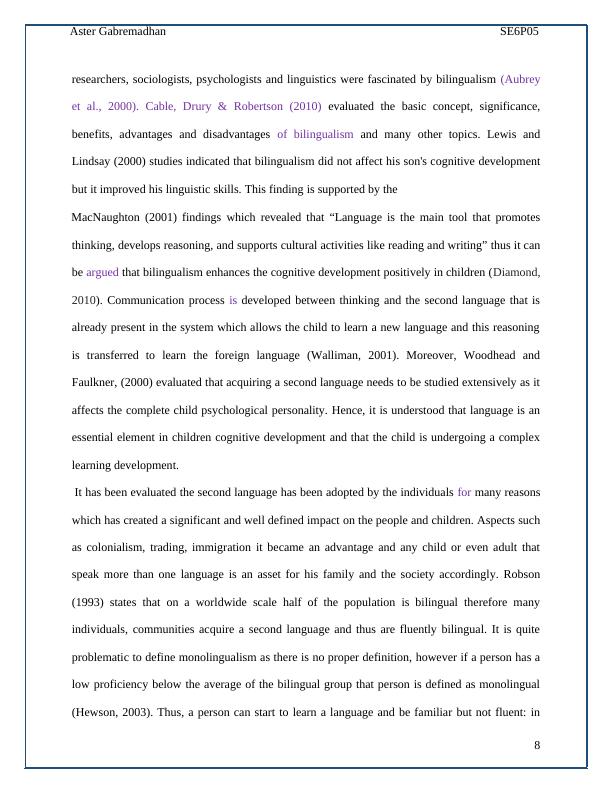
End of preview
Want to access all the pages? Upload your documents or become a member.
Related Documents
Supporting Multilingual Children: Ways for Parents and Practitionerslg...
|56
|15472
|260
A Qualitative Study in Early Childhood Education and Carelg...
|77
|21335
|42
Health and Social Care (HSC) Management Assignmentlg...
|65
|17941
|37
Reflection on Communicationlg...
|8
|2102
|448
Research and Practice in Early Childhood Educationlg...
|6
|771
|218
Identifying the Major Causes and Impacts of Child Poverty in United Kingdom ABSTRACTlg...
|26
|9292
|263